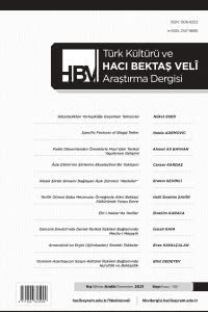İSMAİL HAYR BEY İSYANI IŞIĞINDA OSMANLI-NUSAYRİ İLİŞKİLERİ
Nusayri, İsmail Hayr Bey, Safita, Suriye
Ottoman-Nusayri Relations in the Light of Ismail Hayr Bey Revolt
Nusayris, İsmail Khayr Bey, Safita, Syria,
___
- Hariciye Mektubi (HR. MKT.), 197/48, 193/90, 247/63, 296/94.
- Meclis-i Vâlâ Riyâseti Belgeleri (MVL.), 74/84, 315/36, 750/5, 750/107, 754/62, 753/18.
- Iradeler Dahiliye (I.DH.), 409/27058.
- Sadaret Amedi Kalemi Defteri (A. AMD.), 83/17.
- Sadâret Mektûbî Kalemi, Nezâret ve Devâir (A.} MKT. NZD.), 262/73, 124/42.
- Sadaret Umum Vilayet Evraki (A.MKT. UM.), 336/55, 390/59.
- Sadaret Mühimme Kalemi (A.MKT. MHM.), 144/6, 337/3, 757/110.
- FO. 195/587, Mercer to Moore, Beyrout, 26 October 1858
- FO. 195/587, Moore to Mercer, Beyrout, 27 October 1858.
- FO. 78/1386, From Mercer to Moore, 22 November 1858.
- FO. 195/587, Moore to Malmesbury, Beyrout, 23 November 1858.
- Aytekin, E. Attila. (2012). “Peasant Protest in the Late Ottoman Empire: Moral Eco- nomy, Revolt, and The Tanzimat Reforms”. IRSH, 57, 191-227.
- Baer, Gabriel. (1982). Fellah and Townsman in the Middle East. London: Frank Cass.
- Barkey, Karen. (2008). Empire of Difference. The Ottomans in Comparative Perspe- ctive. Cambridge: Cambridge University Press.
- ——.(1991). “Rebellious Allience: The State and Peasant Unrest in Early Seveente
- enth- Century France and the Ottoman Empire.” American Sociological Review, 56, 6, 699- 715.
- Bilgili, Ali Sinan vd. (2010). Osmanli Arsiv Belgelerinde Nusayriler ve Nusayrilik (1745-1920). Ankara: Gazi Üniversitesi Türk Kültürü ve Hacı Bektaş Veli Araş- tırma Merkezi Yayınları.
- Braudel, Fernand. (1995). The Mediterranean and the Mediterranean World in the Age of Philip II., Vol. I. Berkeley: University of California Press.
- Çapar, Ali. (2013). “The History of Nusayris (‘Alawis) in Ottoman Syria, 1831-1876.” Unpublished Master Thesis: University of Arkansas.
- Douwes, Dick. (1993). “Knowledge and Oppression; the Nusayriyya in the Late Ot- toman onale dei Lincei.
- Dussaud, René. (1900). Histoire et religion des Nosairis. Paris.
- El-Tavil, Muhammed Emin Galib. (2015). Nusayriler, Arap Alevilerin Tarihi, Çev. İsmail Özdemir. Adana: Karahan Kitapevi.
- Farah, Caesar E. (2000). Politics of interventionism in Ottoman Lebanon, 1830-1861. London: I.B. Tauris.
- Firro, Kais. (1992). A History of the Druzes. Leiden.
- Goldsmith, Leon T. (2015). Cycle of Fear: Syria’s Alawites in War and Peace. Lon- don: Hurst and Company.
- Halm, Heinz. (1995). “Nusayriyya”. Enyclopaedia of Islam, VIII. Leiden: E. J. Brill, 145-148.
- Jessup, Henry Harris. (1910). Fifty-Three Years in Syria. Fleeming H. Revell Com- pany.
- Jabbour, Georges. (1995). “Safita et son environnement au XIXe siècle.” Histoire Économique et Sociale de l’Empire Ottoman et de la Turquie (1326-1960). Pa- ris: Peeters, 605-617.
- Khuri, Fuad I. (1991). “The Alawis of Syria: Religious, Ideology and Organization”. Syria: Society, Culture, and Polity. Albany, N.Y.: State University of New York Press.
- Kurt Lee, Mendenhall. (1991). Class, Cult and Tribe: The Politics of Alawi Separa- tism in French Mandate Syria. Austin: University of Texas.
- Lewis, N. Norman. (2009). Nomads and Settlers in Syria and Jordan, 1800-1980. Cambridge: Cambridge University Press.
- Lyde, Samuel. (1860). The Asian Mystery: Illustrated in the History, Religion, and Present State of the Ansaireeh or Nusairis of Syria. London: Longmans.
- Makdisi, Ussama. (2000). “Corrupting the Sublime Sultanate: The Revolt of Tanyus Shahin in Nineteenth-Century Ottoman Lebanon.” Comparative Studies in So- ciety and History, Vol. 42, 1, 180-208.
- Ma’oz, Moshe. (1968). Ottoman Reform in Syria and Palestine 1840-1861. Oxford: Clarendon Press.
- Moosa, Matti. (1987). Extremist Shiites: The Ghulat Sects Contemporary Issues in the Middle East. Syracuse, N. Y: Syracuse University Press.
- Porath, Yehoshua. (1996). “The Peasant Revolt of 1858-1861 in Kisrawan”. Asian and African Studies 2, 77-157.
- Procházka-Eisl, Gisela and Procházka, Stephan. (2010). The Plain of Saints and Prop- hets The Nusayri Alawi Community of Cilicia (Southern Turkey) and its Sacred Places. Harrassowitz Verlag.
- Reyhani, Mahmut. (1997). Gölgesiz Işıklar II. Tarihte Aleviler. İstanbul: Can Yayın- ları.
- Talhamy, Yvette. (2010). “The Fatwas and the Nusayri/Alawi of Syria.” Middle Eas- tern Studies, 46, no. 2,175-194.
- ——. (November 2012). “The Nusayri and Druze Minorities in Syria in the Nine- teenth Century: The Revolt against the Egyptian Occupation as a Case Study”. Middle Eastern Studies, 973-995.
- ——. (2008). “The Nusayri Leader Isma’il Khayr Bey and the Ottomans (1854-58).” Middle Eastern Studies, 44:6, 895-908.
- Türkyilmaz, Zeynep. (2009). “Anxieties of Conversion: Missionaries, State and He- terodox Communities in the Late Ottoman Empire.” Yayımlanmamış Doktora Tezi, University of Los Angeles, Los Angeles.
- Walpole, Frederick. (2004). The Ansayrii and Assassins: With Travels in the Further East in 1850 to 1851. Including a Visit to Nineveh Part Three. Kessinger Pub- lishing.
- Winter, Stefan. (2016). A History of ‘Alawis. From Medieval Aleppo to the Turkish Republic Princeton: Princeton University Press.
- ISSN: 1306-8253
- Yayın Aralığı: 4
- Başlangıç: 1994
- Yayıncı: Ankara Hacı Bayram Veli Üniversitesi Türk Kültürü Açısından Hacı Bektaş-ı Veli Araştırmaları Uygulama ve Araştırma Merkezi
Mâtemî’nin Nesrü’l-Le’âlî Tercümesi
SIRAÇ SOSYOPOLİTİK HAREKETİ VE ANŞA BACILI OCAĞI
YAKUP KADRİ KARAOSMANOĞLU’NUN NUR BABA VE İSMAYIL ŞIHLI’NIN DELİ KÜR ROMANINDA İNANÇ İSTİSMAR
HACI BEKTAŞ VELİ’NİN HALİFELERİNDEN KOYUN BABA’NIN BALKANLAR’DAKİ İZLERİ
İSMAİL HAYR BEY İSYANI IŞIĞINDA OSMANLI-NUSAYRİ İLİŞKİLERİ
YAKUP KADRİ KARAOSMANOĞLU’NUN NUR BABA VE İSMAYIL ŞIHLI’NIN DELİ KÜR ROMANINDA İNANÇ İSTİSMARI
YABALI BABA MENKIBELERİNİN KÖKENLERİ ÜZERİNE
